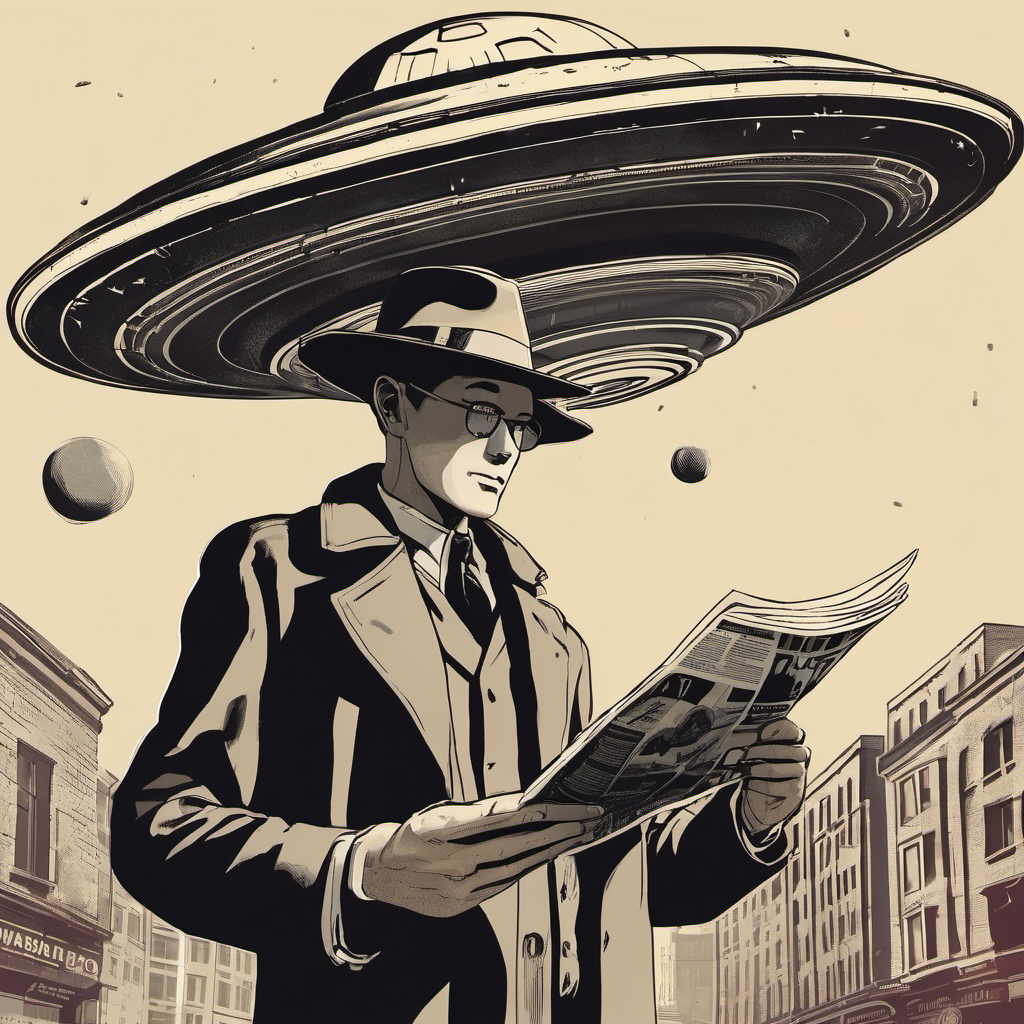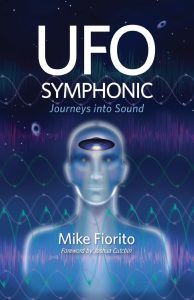
By KEN KORCZAK
I was approaching my review of Mike Fiorito‘s UFO Symphonic with more than a little trepidation because one of the central premises of this book is that music may be fundamental to the very fabric of our existence and may be intricately infused throughout the totality of what we experience as consciousness.
The problem for me is that I don’t listen to music, although I am hugely into UFOs. Thankfully, I was “rescued” early on the musical front by the book’s prelude, written by the brilliant polymath Kevin Cann, who wrote:
“I am one of the least musical people on Earth. I’m a high-functioning autistic with extreme sensory overload symptoms. I try my best to minimize both visual and auditory inputs … I tend to avoid music as much as possible.”
Cann said he loved the book despite his aversion to music. I’m in a similar situation vis-à-vis music. However, unlike Mr. Cann, I don’t avoid music; music avoids me. It just passes me by. I’m not interested in music because I am not affected by it. I am one of the 3% to 5% of people modern psychology identifies as “musically anhedonic.”
Kevin Cann said music can be like “more noise” to him. As for myself, I don’t consider music “noise” but just a neutral sound, say, like the humming of a refrigerator or the sigh of a jet airliner passing overhead at 30,000 feet. I discern little difference between Beethoven’s 9th Symphony and the whir of a Maytag.
Thus, the peculiar challenge for me is that I am attempting to review a book about music while “not being invited to the party,” so to speak. On the other hand, I’ve been “partying hard” within the UFO community for more than 50 years.
By the way, there is a reason for my indifference to music, but I won’t go into that here since I discussed it (albeit only partially — this is an enormously complex subject!) in a previous review of a Mike Fiorito book. You can find that review here: Mescalito Riding His White Horse.
MEMORIES OF A FRIEND
Another thing that made me feel better early on came on page 23 where Mike Fiorito brought back warm memories of an old friend by launching into a discussion of my former “snail mail” pen pal — Terrence McKenna.

Many years ago, the cultural icon, ethnobotanist & “heroic” psychotropic substance warrior and I exchanged “old school” paper-and-ink letters from time to time. This was before email had become a pervasive “thing” in the early 1990s.
It was one day in 1992 that I was gob-smacked to receive a kind and graceful “thank you letter” from Terrence after he read my review of his then recently published book, Food of the Gods. My review appeared in an academic literary publication issued jointly by the University of North Dakota’s (UND) English and Mass Communications Departments. I was the chief science writer for UND’s Center for Aerospace Sciences at the time.
He said in his letter: “I’ve never read a more thorough and penetrating review of any of my works… ”
Terrence’s letterhead was so cool! Each sheet was imprinted with an up-to-date graphic of his famous “Time Wave Zero” chart. This plots the universe’s ongoing calculation of the production of novelty and conservation of novelty — with the idea that as the complexity of the universe increases, so does novelty. The up-and-down oscillation of the wave displays a flux between habit and novelty, respectively. All of this is leading toward a “singularity of infinite complexity,” Terrence suggested.

I NURTURED THE FOOD OF THE GODS
After a couple of years of exchanging letters, I was surprised again one day to receive a small package from Terrence. Inside was a glass microscope slide. Sealed beneath a slipcover on the slide were spore samples from some remarkable hallucinogenic mushrooms he was propagating in Hawaii, if I remember correctly.
An avid gardener my entire life, I managed to nurture this delicate “Food of the Gods” in a modified terrarium-like container, although I never ingested the magic shrooms. Experimenting with those kinds of organic, psychotropic resources has never been an element of my exoconscious-exploration oeuvre, so to speak.
That was okay with Terrence. I think he thought it was nifty that I had grown tropical mushrooms during a frigid northern Minnesota winter. The year was either ’95 or ’96 when we broke records for cold. Tower, MN, reached 60-below-zero Fahrenheit (not including wind chill) that year. In my location, we reached 52-below-zero on February 2 (my birthday) — but I had sun-nourished shrooms thriving inside an “artificial Hawaiian oasis” within my remote cabin in the Minnesota forest!
BOOK REVIEW INTERRUPTED
Just after I wrote the above paragraph, I felt myself enter a mild drift into an altered state of consciousness. Thanks to 40+ years of daily Zen meditation-enabled observation of my own mind, I recognized that I was spontaneously disassociating into a theta state.
I knew exactly what to do — nothing! I just “let it flow.”
For me, theta is a state wherein I have absolutely no thoughts yet maintain a vivid state of awareness. As it turns out, René Descartes was wrong when he said:“Cogito Ergo Sum” — “I think, therefore I am.”
All readers here can discover Descartes’ error for themselves. If you cultivate a complete shutdown of your thoughts — by practicing meditation, for example — you may be amazed to discover that you still “Are.” That is, you still maintain self-awareness as a discrete Individuated Unit of Consciousness, to borrow a term from Carl Jung.
So, anyway, I leaned back in my office chair and observed in a 100% detached, 100% nonanalytical, nonlinear way as I perceived the ghostly manifestation of a giant mushroom forming and “cocooning” my body.
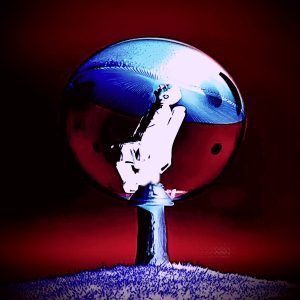
The stipe began at my feet and proceeded upward, enveloping my lower body, then moving upward to blossom with a lenticular cap that stuck out the top of my head.
Soon, I was wholly “inside” the mushroom, although it’s more accurate to say I felt as if the shroom and I were “One” while each of us nevertheless retained our sovereign identities. Then, Ken-as-Shroom-Shroom-as-Ken became enveloped within a spherical “Resonate Energy Balloon.” The latter is a term I borrow from the consciousness explorers at The Monroe Institute.
My merger and integration were so complete, I even sensed the subsurface mycelium of Ken-as-Shroom-Shroom-as-Ken.
The situation can best be viewed as a timeless-spatial event wherein Ken-as-Shroom-Shroom-as-Ken manifested a mutually agreed upon unity infused with a subtle auric undercurrent. I’ll describe the latter as an “homage-connectivity-love-friendship-vibe” informed by some “energy aspect of Terrence.”
There’s so much more, but I’ll stop there because I feel inadequate to properly convey the true nature of this experience — which frustrates language. However, I relate this episode because it made me think afterward:
“Wow! Talk about a UFO Symphonic Moment!”
It’s my notion that my Ken-as-Shroom-Shroom-as-Ken experience gets at the essence of what Mike Fiorito is chasing down in his book.
Consider:
MUSIC — In this case, music manifested as a vibrational informational (i.e., music is a “brand” of vibration) download that delivered encoded information — or data — that communicated to me in a nonlinear or gestalt fashion a very real, visceral reunion with my friend Terrence. An adjutant to the experience was the “thought form packet” Mike Fiorito projected into the Noosphere with the information in his book.
ORGANIC PSYCHOACTIVE SUBSTANCES — Fiorito also reports on certain insights he experienced by leveraging mushrooms. I note that even though I have never engaged in the use of so-called hallucinogenic compounds, I have interfaced with mushrooms in novel ways, including artistic/creative endeavors that have provided me with glimpses of the exotic avenues these “living entities” can impart to us via direct interactive connections.
An example is the photo below, I titled “The Mushroom Goddess.” I extracted this image by engaging in intense interaction with a mushroom I encountered here in my Minnesota forest. My interaction included leveraging various imaging technologies in addition to non-technological methods.

UFO /ALIEN— The UFO element is part of the experience as well. It’s important to note that Terrence suggested mushrooms themselves may be an “alien intelligence” that came to Earth by “seeding” our planet from an extraterrestrial origin. The purpose of this seeding was to seek a symbiotic relationship with any intelligence-consciousness that might already inhabit our planet — or any planet.
In his books and many public lectures, Terrence explained it this way, and here I quote him directly:
“Spores are the most economical biological unit imaginable. They can survive the radiation levels of interstellar travel. They can survive for eons under conditions very close to those encountered in interstellar space …
… the mushroom spore falls into an ecosystem, immediately undergoes cell division. A fine, threadlike network full of neurotransmitters begins to spread itself through the soil. It’s very closely analogous to the neuro-network of a higher animal, including a human being. Now we’re accustomed to thinking that an extraterrestrial would bear the imprint of the evolutionary situation in which it came to be … we ourselves have only possessed the knowledge of the way DNA works for about 40 years.
I think it’s reasonable to assume that if an intelligent species gets 1,000 years of study of DNA that they can design themselves to be however they care to be …
… the major argument for the mushroom as an extraterrestrial is an insider argument. It’s the content of the experience. Number one, it says it’s an extraterrestrial and it has the data to back the claim and show you movies of desert worlds, or jungle worlds, high pressure-high gravity methane worlds, planets whose cores are Helium-4 … you don’t know if you are inside an organism or inside some machinery, whether you are underneath the surface of the planet … (SOURCE)

Indeed, drew our attention to the uncanny resemblance of a classic “flying saucer” UFO to that of a mushroom.
TERRENCE TIMES 10
Well, if you take my experience with Terrence McKenna and multiply it by 10, or maybe 100, you’ll have an idea of the pathway Mike Fiorito plies among a network of extraordinary people. That includes famous & iconic figures along with lesser-known folks, the latter of whom are nevertheless doing extraordinary things.
Mike doesn’t care if you’re famous or not. He’s just interested in what you have to say. If someone is doing something fascinating, if that person can report a remarkable experience, then Mike wants to talk to you — and write about it!
In this book, UFO Symphonic, Fiorito dusts off his journalism bona fides. He lands in-depth interviews with some of the most fascinating thought leaders of our times, from scientists on the cutting edge of astrophysics and biology to giants in the music industry, such as bluegrass demigod and 7-time Grammy nominee and Grammy winner Peter Rowan.
Obscure yet remarkable people are heard from as well. Mike’s method is to step back, give his subjects the stage and let them tell their stories. The result is one absorbing account after another. Mike has a subtle way of drawing out his interview subjects and then nurturing a creative space for them to open up. The result is readers being drawn in and opened to novel ways of contemplating life.
It’s also personal. Throughout his narrative, Mike interweaves his own experiences gleaned from life adventures in pursuit of meaning as it manifests to him to a gigantic extent through music, but also via the acknowledgment that something “Other” is here also informing our Earth-bound experience.

That “Other” can be the persistent materialization of the UFO phenomenon, the spontaneous advent of altered states of consciousness, substance-induced psychedelic experiences and much more — including people’s confrontations with the fundamental issues of life and death itself.
- Music as a fundamental ontological force?
- Psychedelic enhancement of consciousness?
- The presence of Nonhuman Intelligence among us?
If all that sounds like an amazingly innovative premise for a book — well, so it is!
In the hands of a gifted writer, the result is an inspired integration exploring music, but more than music — about UFOs but more than UFOs — and a book about people like you and me placed in the context of a marvelous Multiverse of experience.
It’s a prosy yet mythopoetic shakedown that one might articulate like this:
“Hey, I’m playing at the game of being both a locally and non-locally Individuated Unit of Consciousness! I’m immersed in the mundane yet fantastical condition we call material reality! There’s music here! And UFOs! Life is colorful, imaginative and wondrous! Here is the profound experience I can report!”
NOW WAIT A MINUTE … DOES MUSIC HAVE A DARK SIDE?
I’ll confess, this is about the 10th time I’ve started my review of UFO Symphonic only to fall into a hopeless rut.
What kept tripping me up is that I can’t shake the idea that the natural purity of music is, in many respects, occluded by the folly (or challenges) of humanity.
While Mike’s book is an ardent homage to the divine experience and beauty of music, as an outside observer, I can’t help but ponder the dualistic traps that ensnare all facets of material-based reality. Music strives to penetrate the latter to touch and inform humanity, to bring a sense of hope.
To explore this concept further, I thought:
“What I really need to do is find someone who can articulate the idea that music also has a dark side from a much more authoritative position than I have.”
I also thought:
“Such a person would have to be someone who has achieved stellar heights in musical ability and attainment — while at the same time — has also travelled in the cold, calculating realm of unemotional intellect while he worked in a realm that is unlike the beauty of music.”
Ideally, this person would be a ‘60s-70s-era long-haired hippy guitarist with a couple of Grammy awards under his belt — an inductee to the Rock & Roll Hall of Fame — but also a person who also worked inside the soul-free technical, Military Industrial Complex where he helped develop weapons of war to new levels of lethality.
Well, there is such a person. His name is Skunk Baxter.

Briefly, Jeff “Skunk” Baxter is a two-time Grammy winner who gained fame as a guitarist for two of Classic Rock’s most successful acts: Steely Dan and The Doobie Brothers. Skunk’s remarkable guitar ministrations were at the heart of what made these two bands legendary.
Baxter’s further contributions to music and his collaborations with dozens of other artists are nothing short of mind-blowing and too voluminous to list here. He was inducted into the Rock & Roll Hall of Fame in 2020.
Amazingly, after achieving stellar heights most musicians can only dream of, Skunk Baxter embarked upon a jarring career turn in 1979. After parting ways with the Doobie Brothers, he immersed himself in the study of missile defense. Entirely self-taught, Baxter became knowledgeable enough to parlay his newfound fascination into a second career as a defense analyst and consultant.
Baxter soon found himself launched into a realm wherein his outside-the-box thinking made him a much-in-demand expert for the likes of the U.S. Department of Defense, Northrop Grumman, General Dynamics, General Atomics Aeronautical Systems and others.
In a 2007 interview, Baxter said:
“We thought turntables were for playing records rappers began to use them as instruments, and we thought airplanes were for carrying passengers until terrorists realized they could be used as missiles. My big thing is to look at existing technologies and try to see other ways they can be used, which happens in music all the time and happens to be what terrorists are incredibly good at.”
So, it’s not surprising that Baxter has suggested that music is a force that “makes people feel incredibly good” — but that it can also drive people to madness, self-loathing, depression and anger. It can goad people into committing acts of violence.
This echoes statements written by music-industry biographer Stephen Davis. In his book, Hammer of the Gods (about Led Zeppelin), Davis notes that music historically has been used to whip men into a frothy lust for the horrors of combat. Davis also explains that music can sow discord and chaos in society — a scathing critique often directed at Led Zeppelin by many social critics of the time. (Note: The book was condemned as “garbage,” a “sad little book,” and “a catalog of error and distortion” by Robert Plant, Jimmy Page and John Paul Jones. Just FYI).
BACK TO SKUNK
Speaking at the European InnoTown Innovation Conference about eight years ago, Skunk Baxter held an audience in rapt attention as he explained the confluence of music and man in terms of music’s ability to send people into states of transcendent delight or drive them to destructive madness.
As an example of the latter, Baxter suggested that a set of chords known as “The Devil’s Interval” is corrosive to the human psyche. He said that’s because this sequence of music has “no even harmonics.” It’s also known as “The Tritone” and “Diabolus in musica” (The Devil in Music).
One of the best examples of The Devil’s Interval can be found in the Toccata and Fugue in D minor, a musical creation most associated with Johann Sebastian Bach — although musical scholars hotly debate the true authorship/origin of this piece.
Whatever the case, Baxter told his audience that Bach made a critical mistake when he played his composition for the first time at St. Nicholas Church in Leipzig because “the audience proceeded to riot and burn down the church.” Baxter contends that the nefarious influence of nonharmonic chords drove the audience to madness.
He then offered another example. Baxter said that Igor Stravinsky was enamored with the Toccata and Fugue in D Minor and so incorporated a similar inharmonic musical structure into his groundbreaking ballet, The Rite of Spring. It was performed for the first time at the Théâtre des Champs-Élysées in Paris on 29 May 1913.
Once again, the result was destructive mayhem. The music of the Rite of Spring whipped the audience into such a mad frenzy, it caused them to form a mob that “looted six blocks of downtown Paris — scared the hell out of everybody,” said Baxter.
But wait a minute …
After I watched Baxter’s presentation on YouTube, I became suspicious about these sensational stories. I did some research and quickly discovered that:
The parishioners did not burn down the church upon hearing Bach play the Toccata and Fugue in D minor on a pipe organ. Indeed, historians are uncertain about where Bach played the piece for the first time or anywhere, be it in a church venue or elsewhere. Thus, Baxter’s example is apocryphal at best.
I also discovered that the audience at the 1913 presentation of Stravinsky’s Rite of Spring did not pillage six city blocks in Paris. It’s true that there was an incident of audience “disruption and outrage” during the ballet — but most scholars agree the Rite of Spring audience disruptions (which may have involved fistfights, a stampede, a stabbing and more) — had little to do with Stravinsky’s music.
It probably had more to do with the ballet’s choreography created by Vaslav Nijinsky. The audience found the movements of the dancer as “bizarre,” “repugnant,” and an “affront to dignity.”
And consider that Bach’s Toccata and Fugue in D Minor would later be the first piece featured in the 1940 Disney film Fantasia — to the delight of children and adult audiences alike. The music featured an orchestra aglow with blue and gold light braced by shadows that morphed into abstract illustrations.
In short, no one burned down any movie theaters in 1940 upon listening to “The Devil’s Interval” spun with an enchanting Disneyesque spin.
Skunk Baxter made numerous other claims in his presentation to the InnoTown Conference that I didn’t have to Google to know they were … well …. I’ll just say “a tad off the mark.” For example, Baxter named Nobel Prize-winning physicist Charles H. Townes as “the inventor of the laser” when it is widely agreed that physicist Theodore Maiman, Ph.D., invented the laser — though I admit the earlier work of Charles Townes (a friend and colleague of Baxter’s) made the laser possible.
My point is: Yes, Skunk Baxter holds a unique position to relate insights to us all about the deeper nature of music and humanity’s relationship with it, but he also has a penchant for … for … I’ll just call it, “creative interpretation of the facts.” On the other hand, his observations about The Devil’s Interval are not without merit. Many people find it strangely unsettling and disturbing. That’s why we hear some form of the Devil’s Interval in horror movies.
For example, in the 1931 movie Dr. Jekyll and Mr. Hyde, director Rouben Mamoulian selected the Toccata and Fugue in D minor to “represent the evil of Dr. Jekyll” and to “imbue the audience with a sense of spooky suspense.”
Another famous example of a musical piece informed by “inharmonic partials” is Tubular Bells penned by Mike Oldfield. Most social observers suggest that the real reason Tubular Bells makes many people feel an “immediate sense of dread” is because they probably heard it for the first time in the 1972 movie, The Exorcist, arguably the most frightening and psychologically disturbing movie ever made.
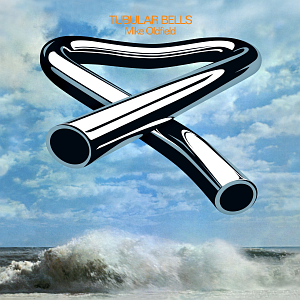
The notion here is that there is nothing inherently upsetting in the sound of Tubular Bells, but rather, people associate it with the frightening experience of sitting in a dark theater and watching a 12-year-old girl projectile vomit on Catholic priests and brutally self-mutilate her vagina with a crucifix.
On the other hand, Mike Oldfield himself said that Tubular Bells was a way to exorcise (no pun intended) his psychological inner demons and that writing it “disturbed him on a deep level” — although it was also cathartic and, therefore, a healing experience.
And yet — Oldfield’s Tubular Bells album was a smash success. It launched one of the most successful musical labels of all time — Richard Branson’s Virgin Records. Tubular Bells was the first release for Virgin, and it sold more than 15 million copies. It begs the question: If the “inharmonic” Tubular Bells is so disturbing to the human psyche, why do so many people want to listen to it and even spend their hard-earned money to own the album for repeat listening?
MUSIC AND SILENCE AS ONE?
But now let me return to one statement in Skunk’s presentation. He said that musical vibrations start from a point of “no vibrations, all the way down a linear path to pure energy.”
For me, the key words in his statement are “no vibrations.” It was either an unintentional or tacit admission that there are spaces in our reality where there are no vibrations but only perfectly profound silence of “Nothing” — but “Nothing” with a capital “N.”
In other words, the premise that our reality is made up of not solid objects but of vibrational frequencies “acting as solid matter” tends to miss that even these “vibrational frequencies” are fundamentally dependent on a background of no sound at all, no vibrations — Nothing.
This Nothing is the ultimate ground of reality. It’s not a cold, empty “Void,” however. Paradoxically, it’s a “Dynamic Nothing.” Hearken back to my statements that experiencing a state of “no thought” nevertheless allows the realization of “Pure Awareness.” In my experience, the latter is timeless and does not “vibrate.” It contains no information — yet we can perceive it.
In music, the silences between notes are called “rests.” Musical scholars tell us that the silences between notes are as much a part of music as the notes we hear. Music cannot be heard or comprehended without Silence.
Claude Debussy said: “Music is the space between the notes.”
Mozart said: “Music is not in the notes but in the silence between.”
SO …
After much back-and-forth consideration (and more trepidation), I opted to include a discussion on the dark side of music, and its fundamental interplay with the Silence of Pure Awareness not because Mike Fiorito discusses it directly but because I came away from UFO Symphonic with the inescapable conviction that it is implied between the lines of the narrative.
Somewhere along the way of writing more than 1,000 book reviews over the decades, I’ve adopted a technique wherein I not only reads the words of a book and the meaning they convey — but I also strive to “open my heart chakra” to “read the energy” of a book, not just the words.
Furthermore, from reading Mike Fiorito’s other books I gather he is a student of Carl Jung, and as such, is likely familiar with Jung’s concept of the “Shadow Self.” For me, the “Shadow Aspect of Music” whispers subtly in the silent space between the words of UFO Symphonic.
Whatever the case, that’s a good thing, not a bad thing.
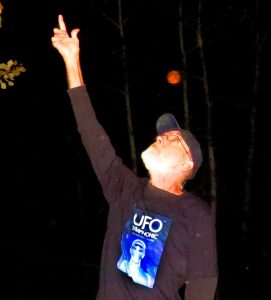
JOIN ME ON BLUESKY: KEN-ON-BLUESKY
NOTE: For more in-depth book reviews, please see: KEN-ON-MEDIUM
